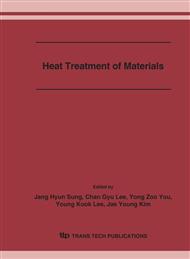p.149
p.155
p.161
p.167
p.173
p.179
p.185
p.191
p.197
Effect of Hot-Dip Silicon-Aluminizing on the Anti-Carburization Behavior of High-Temperature-Resistant Steel HK40
Abstract:
High-temperature-resistant (HTR) austenitic steel HK40 is employed for being silicon-aluminized by being hot-dipped in molten aluminum and silicon alloys and diffused subsequently at 1200°C. The phases, microstructures and concentration for elements of interest in the treated case are investigated by x-ray diffraction (XRD), optical microscopy (OM), scanning electron microscopy (SEM) and energy dispersive spectrum of x-ray (EDS). The case composes of three main zones: the former hot-dipped coating zone, inter-diffusion zone, and diffusion zone of Al and Si, all of which contain quite higher contents of aluminum and silicon than substrate. Pack-carburization is used for assessing the anti-carburization behavior of the treated case. The treated case shows excellent property in hindering the inward-diffusion of carbon, even if the former hot-dipped coating zone spalls off with only diffusion zone left. High contents of aluminum, silicon and oxygen are still detected on surface of the silicon-aluminized specimen after carburization. Good anti-carburization ability of the silicon-aluminized specimen is believed mainly to be the result of the dense and stable Al2O3 and SiO2 films formed on the surface.
Info:
Periodical:
Pages:
173-178
Citation:
Online since:
December 2006
Authors:
Price:
Сopyright:
© 2006 Trans Tech Publications Ltd. All Rights Reserved
Share:
Citation:


